All issues

Volume 43, Issue 6
Displaying 1-3 of 3 articles from this issue
- |<
- <
- 1
- >
- >|
-
1974Volume 43Issue 6 Pages 535-610
Published: June 25, 1974
Released on J-STAGE: August 05, 2011
JOURNAL FREE ACCESSDownload PDF (26824K) -
Shigeo Akashi, Mitsuhiro Natsume1974Volume 43Issue 6 Pages 611-618
Published: June 25, 1974
Released on J-STAGE: August 05, 2011
JOURNAL FREE ACCESSIt has been recognized empirically by engineers that the angular distortion on welded joint, which is caused by the eccentric shrinkage of deposited metal, is somewhat related with weld cracking.
The purpose of this work is to evaluate quantitatively the resistance force against angular distortion, naming it as "Bending Restraint Intensity", and also to clear experimentally the role of bending restraint in the cracking behavior.
The definition of Bending Restraint Intensity is given as "Bending moment intensity per unit weld length required to cause unit angular distortion at joint, KB=M/θ, kg.mm/mm. rad".
Bending Restraint Intensity possessed in self-restraint specimens now being used for cracking tests is to be calculated by finite element method. For the joints with no self-restraint a loading apparatus was devised to give optional KB.
The weld cracking tests were made on these restrained joints of different types; one was one pass welds with bending and tensile restraint, one was multipass weld with bending restraint, and the other was partially penetrated multipass weld with bending restraint.
Included in this paper is description on the property of bending restraint, the testing apparatus, results of cracking tests with given Bending Restraint Intensity, and a summary and interpretation of the results.View full abstractDownload PDF (3656K) -
Fillet weldingKei Sumitomo, Yasuiti Murao, Masanobu Hamasaki1974Volume 43Issue 6 Pages 619-626
Published: June 25, 1974
Released on J-STAGE: August 05, 2011
JOURNAL FREE ACCESSAuthors have been studied underwater fire cracker welding which is one of the improving method for welds in underwater. As the result of applying it to fillet joint, following conclusions were obtained.
1) Excellent welds without cracks and blowholes were obtained both method by single coated electrode and by twin coated electrode.
2) In the case of welding used with twin coated electrode, bared rod was set in the corner of the fillet, because of prevention from the intrusion of water into there, and so successfull fillet weld was obtained by using parallel arc method, however, series arc method was used, only in the case of arc starting.
3) The range of proper welding conditions became comparatively widely.
4) The long size stick coated electrode could be used in underwater because of cooling effect.
5) Good welds could be obtained under sea water as well as in air atmosphere.View full abstractDownload PDF (9746K)
- |<
- <
- 1
- >
- >|